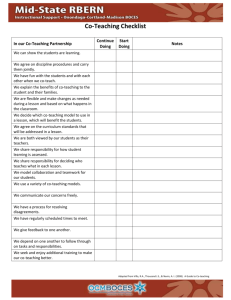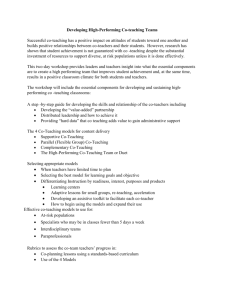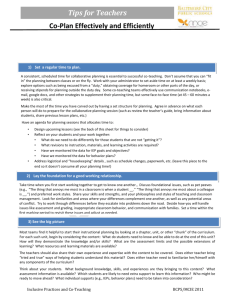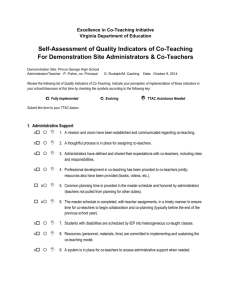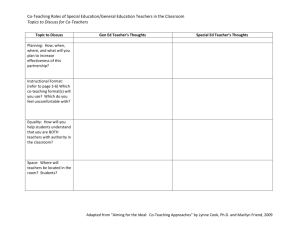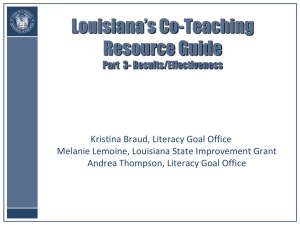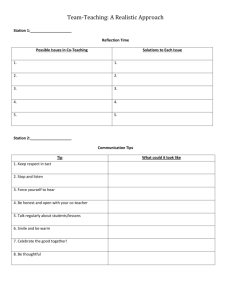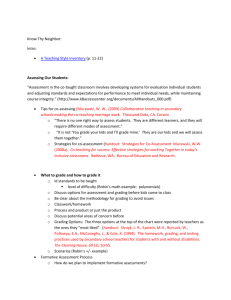Weymouth Handouts for 2-Day Co-Teaching
advertisement
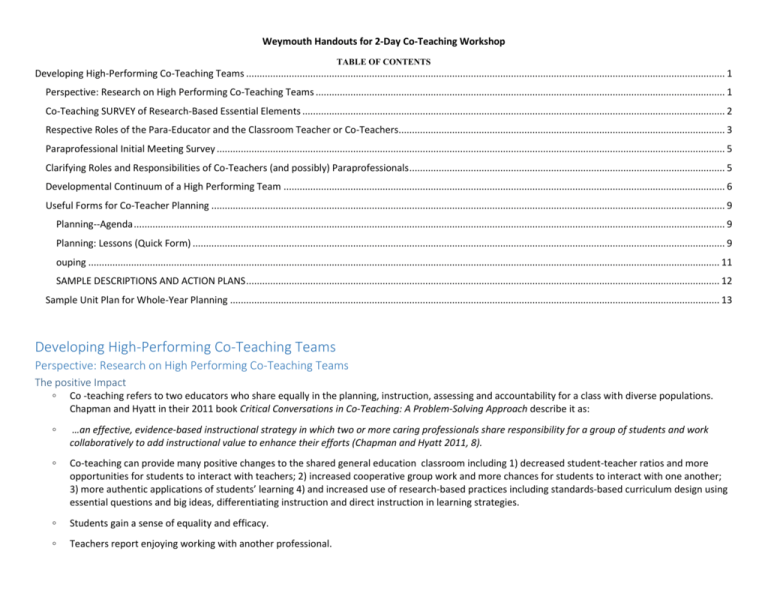
Weymouth Handouts for 2-Day Co-Teaching Workshop TABLE OF CONTENTS Developing High-Performing Co-Teaching Teams ................................................................................................................................................................................... 1 Perspective: Research on High Performing Co-Teaching Teams ......................................................................................................................................................... 1 Co-Teaching SURVEY of Research-Based Essential Elements .............................................................................................................................................................. 2 Respective Roles of the Para-Educator and the Classroom Teacher or Co-Teachers.......................................................................................................................... 3 Paraprofessional Initial Meeting Survey .............................................................................................................................................................................................. 5 Clarifying Roles and Responsibilities of Co-Teachers (and possibly) Paraprofessionals ...................................................................................................................... 5 Developmental Continuum of a High Performing Team ..................................................................................................................................................................... 6 Useful Forms for Co-Teacher Planning ................................................................................................................................................................................................ 9 Planning--Agenda ............................................................................................................................................................................................................................. 9 Planning: Lessons (Quick Form) ....................................................................................................................................................................................................... 9 ouping ............................................................................................................................................................................................................................................ 11 SAMPLE DESCRIPTIONS AND ACTION PLANS ................................................................................................................................................................................. 12 Sample Unit Plan for Whole-Year Planning ....................................................................................................................................................................................... 13 Developing High-Performing Co-Teaching Teams Perspective: Research on High Performing Co-Teaching Teams The positive Impact ◦ Co -teaching refers to two educators who share equally in the planning, instruction, assessing and accountability for a class with diverse populations. Chapman and Hyatt in their 2011 book Critical Conversations in Co-Teaching: A Problem-Solving Approach describe it as: ◦ …an effective, evidence-based instructional strategy in which two or more caring professionals share responsibility for a group of students and work collaboratively to add instructional value to enhance their efforts (Chapman and Hyatt 2011, 8). ◦ Co-teaching can provide many positive changes to the shared general education classroom including 1) decreased student-teacher ratios and more opportunities for students to interact with teachers; 2) increased cooperative group work and more chances for students to interact with one another; 3) more authentic applications of students’ learning 4) and increased use of research-based practices including standards-based curriculum design using essential questions and big ideas, differentiating instruction and direct instruction in learning strategies. ◦ Students gain a sense of equality and efficacy. ◦ Teachers report enjoying working with another professional. What Co-teaching is NOT ◦ When the role of the second educator or paraprofessional is limited to that of an untrained assistant or volunteer, this is not a collaborative teaching partnership. Duties that include duplicating materials, correcting objective exams, or other jobs that do not require training are not included as appropriate responsibilities in the true co-teaching relationship. In addition, if the second person provides educational services exclusively to one student, for example, a special educator who serves as a tutor for a specific student, or a behavior specialist who observes specific students, this is also not co-teaching. ◦ The second professional must be a partner in teaching the entire class. Thus, co-teaching requires equal participation of two educators whose partnership and shared leadership result in providing a more effective model as they both plan, instruct, and monitor the progress of all students than either could have accomplished alone. Again, the critical factor for co-teaching is the professional partnership and the teachers’ commitment to the team’s ongoing development. To move a co-teaching team to the value added level of improving student achievement more than they would have working alone, it is essential that the following four areas are working effectively and improving on an ongoing basis. In addition to the time spent planning for the classroom, the partners need to spend time on their partnership and its development. According to Chapman and Hyatt, co-teachers need to have 4 ongoing critical conversations about their relationship and their classroom. The topics should include the following four topics that are sustained throughout the co-teaching partnership. Co-teachers need to consistently revisit and reflect on how they: 1. Define the Partnership: Partners develop a shared vision, establish roles and responsibilities, and lay the collaborative foundation that may need adjusting throughout the year 2. Examine Data: Together they focus on results, use data about students to make instructional improvements and become more adept at adjusting materials and instruction to support each student 3. Enhance Instruction: They focus on ways to provide more value as a twosome than one teacher could do alone and continue to learn together about research-based methods that work for their students 4. Expand Impact: They recognize that they are part of a school system and that they need to have administrative support for their work together and for professional development that will support the school and the team’s capacity for improving instruction (Chapman and Hyatt 2011, 10-11). According to Chapman and Hyatt, models need to be addressed, but the true value added component of co-teaching comes from the partnership’s growth which will take place over time as the four areas listed above are consistently considered, critically and reflectively, during the co-teaching meetings and in the classroom. Co-Teaching SURVEY of Research-Based Essential Elements Essential Element The Partnership Collaborative Relationship Description Both co-teachers have equal voice in the planning, teaching, and grading. Their Roles and Responsibilities are clear Totally True Somewhat True Not Yet The Partnership The Partnership The Partnership The District The Classroom The Classroom The Classroom The Classroom The School Expertise of CoTeachers is fully used Has Parity Has a Plan to Resolve Conflict. Time for Collaboration is Provided Both co-teachers are seen as experts in the classroom. Content Expertise and Learning Support Expertise are provided for every child Both teachers share the classroom space, all students, and decisions equally When there are differences of opinion, the issue is directly confronted as soon as possible The district provides definite planning time during the school day. Climate Supports Co All students ask questions of both co-teachers equally teaching Practices Is Heterogeneous The classroom has a balance of all levels of achievement; it’s not a “low level” class Has Appropriate Co-teaching is completely supported with materials for Space and Materials all students The Co-teaching Whole class teaching with the co-teacher assisting is Models Are Varied NOT the main model. They use data to flexibly group students in many ways: parallel teaching, station teaching, small-large group teaching, individual conferencing The Climate It is clear that the co-teaching model is considered an Supports Coimportant support both for students with needs and for teaching, Inclusion general education student. and Teaching All Students. TOTAL EACH COLUMN Respective Roles of the Para-Educator and the Classroom Teacher or Co-Teachers Classroom Teacher or CoTeacher Responsibility Para-educator Role Materials, Supports for Paraeducator Instruction Plan all instruction for whole class and small groups Teach whole class and small groups Work with small groups of students on specific tasks, including review or re-teaching of content Discuss specific classroom instruction plans that may have an impact on the paraprofessional Para will be trained in all needed routines and ways to work with students This will be a gradual process that will change when the students and paras are prepared for the next step All materials will be provided with directions and answers at least initially Curriculum & Lesson Plan Development Plans for year, week, and daily instruction Leads (or works with co-teacher) to teach whole class and groups Provide assistance in development of classroom activities, retrieval of materials, and coordination of activities as the year goes on Discuss specific curriculum and instruction plans that may have an impact on the paraprofessional Plans and materials will be reviewed New techniques will be modeled and discussed before the para is responsible Classroom Management and Classroom Climate Provide classroom rules, norms, consequences When there are individual behavior plans, they will be discussed with the para-educator Assist with the implementation of class-wide and individual behavior management plans Discuss all classroom management concerns that may have an impact on the para-professional Teachers discuss classroom rules, processes and procedures. Individual behavior plan processes will be discussed When necessary, provide appropriate accommodations to material (enlarged print, taking notes, reading material aloud) Discuss all accommodation and modification concerns that may have an impact on the paraprofessional Purpose of accommodations and modifications will be discussed Para-educator may need to provide feedback about their usefulness Provide accommodations (separate location) read materials, etc., when asked. Assist in giving assessments Discuss all classroom assessment issues that may have an impact on the para-professional The para-educator needs to discuss any concerns that she has about her role and her relationship with Training and modeling of all expectations will be provided Schedule meeting times and specify what will be discussed Accommodations & Responsible for all Modifications accommodations and modifications Assessment Develop, analyze, modify, and use assessment results to plan classes Communication Discuss how you will communicate, plan, and solve any problems that arise Provide a plan for discussing concerns Schedule meetings Specify method(s) of communication that may include email, instant messaging, notes, etc. Supervision/Evalu Discuss these responsibilities as ation defined by the school the classroom teacher or coteachers or with individual or groups of students Develop a communication plan to provide lessons, discuss concerns If there are rubrics, forms, processes and procedures, each should be discussed with the paraprofessional Develop a plan or schedule if this is part of your role with the paraprofessional Paraprofessional Initial Meeting Survey . Major Strength Some Strength I could learn something about This is a challenging area that I could learn about Experience in GE classroom Experience in SE classroom Experience with co-taught classrooms Facilitating small groups Re-teaching Technology Communicating about plans using lesson plans or technology (email, phone, IM, etc.) Content area of class PD/Training/Experience in learning difficulties Successful experiences you’ve had in education Any questions that you have Clarifying Roles and Responsibilities of Co-Teachers (and possibly) Paraprofessionals Teacher A Planning for the year Planning for the week Preparing materials Teacher B Paraprofessional(s) Shared Concerns, Notes Grading tests, quizzes, classwork, homework Collecting, organizing and analyzing data Classwork, homework, observations, formative and summative data Classroom routines (attendance, make-up work, passes, behavior problems, meetings, schedules, IEPs, team meetings) Our 2 PD goals for the year Our scheduled meeting days/times for the year Developmental Continuum of a High Performing Team Criteria Novice Begin Develop Developing Fairly Generally Mainly Proficient Generally consistently Generally effectively Generally reliably Partnership Begin to set goals using Co-Teaching Progress Rubric/Tracker Begin to clarify on roles and responsibilities using Teacher Skills Survey Begin to set standards for classroom routines, behavior using the Roles and Responsibilities Matrix Measure progress on goals fairly often and adequately Roles and Resp. getting clarified Norms generally observed Meetings mainly effective Problem solving protocol mainly works Daily/weekly communication plan mostly works Other: Measure goal progress generally consistently Roles and Resp. generally consistently clarified Norms observed generally consistently Meetings generally are effective Problem solving protocol works generally effectively High-Performing Team Next Consistently Steps for Mutually Wholly Naturally Goals are mutually shared and measured by each teacher and team consistently Roles and Resp. consistently clarified Norms observed consistently Meetings consistently effective Problem solving protocol works well consistently Develop daily/weekly communication plan Daily/weekly communication plan generally works reliably Other Co-planning Begin to plan for full year’s meeting schedule Develop agenda format Develop Lesson Plan format (long form) Develop weekly lesson plan format (short form) The full year’s meeting schedule mainly works The agenda format mainly works Lesson Plan format (long form) mainly works Weekly lesson plan format (short form) mainly works Daily/weekly communication plan consistently works efficiently Other The full year’s meeting The full year’s meeting schedule generally works schedule works effectively effectively and consistently and consistently The agenda format The agenda format works generally works effectively effectively and consistently and consistently Lesson Plan format (long Lesson Plan format (long form) works effectively and form) generally works consistently effectively and consistently Weekly lesson plan format Weekly lesson plan format (short form) works (short form) generally effectively and consistently works effectively and consistently Co-teaching Models Used are Highlighted Whole Class: One teach/One observes One teaches/One drifts One teaches/One assists or supports One teaches/One adapts the curriculum Small Group Parallel Teaching Alternative Skill Group Learning Styles Models Used are Highlighted Whole Class: One teach/One observes One teaches/One drifts One teaches/One assists or supports One teaches/One adapts the curriculum Small Group Parallel Teaching Alternative Skill Group Learning Styles Models Used are Highlighted Whole Class: One teach/One observes One teaches/One drifts One teaches/One assists or supports One teaches/One adapts the curriculum Small Group Parallel Teaching Alternative Skill Group Learning Styles Models Used are Highlighted Whole Class: One teach/One observes One teaches/One drifts One teaches/One assists or supports One teaches/One adapts the curriculum Small Group Parallel Teaching Alternative Skill Group Learning Styles Stations Duet All models Coassessing and cograding Using Data Improving Practice Stations Duet All models Stations Duet All models Stations Duet All models Assess all major assignments together Use mutually developed rubrics Rubrics can include modified work Do report cards and progress reports together and mainly agree Examine standardized Student work is used at assessments, IEPs, and the end of each marking previous grades together period to assess the Use these assessments to effectiveness of teaching set goals and plan for year and to set goals for the next quarter Assess together Use common rubrics Grade report cards and progress reports together Use results to plan for the next week or unit Assess together with rubrics that are mutually created Grade together Use classroom results to develop flexible groups and to modify instruction for the week and for the year Consistently use classroom assessments formatively to modify groups and plans to differentiate instruction Begin to track at risk students’ progress This rubric is used to assess present state of and to assess growth in differentiating instruction, developing group work, formative assessment of student work to adjust curriculum, IEP goals, UDL, RtI and/or local or self-selected PD initiatives The DI groupings are varied as need is demonstrated in the class. UdL, RtI, and/or specific local initiatives are generally employed in planning and teaching Data from observations, behavior, classroom assessments, qualitative and quantitative are used consistently and effectively to plan and to monitor student progress throughout the year. Universal Design for Learning, Differentiating Instruction, Response to Intervention, and other local or team-based PD are consistently to support effective teaching and progress monitoring for all students. Begin to assess students’ work together and to set mutually agreed upon standards Begin to develop rubrics, scoring sheets together Differentiating instruction is begun in parallel groupings include flexible groups that reflect need, interests, self-selection, learning styles, stations, etc. Co-teachers have begun to work on new-to-one or both co-teachers specific PD or initiatives School-wide Inclusion using the Co-Teaching Progress Rubric Co-teachers look at the status of school-wide inclusion: principal support, teacher attitudes, teacher support, time allotted, progress, needs Co-teachers begin to discuss the status of school-wide inclusion with administrators and teachers Co-teachers provide regular feedback to administrators and teachers about the status of inclusion. They may provide workshops in the school. Co-teachers advocate for inclusion and provide regular feedback to administrators and teachers about the status of inclusion. They may provide workshops in the school. Useful Forms for Co-Teacher Planning Planning--Agenda Meeting Date Minutes Recorded by: Time 5 min 5 min 5-10 min 30 min 10 min 5 min People Present Follow-Ups necessary: AGENDA Review Agenda and Positive Results since the last meeting Review the Co-Teaching Progress Rubric/Tracker to make sure you keep all of your priorities in focus Review student needs, student work, student data Plan for the next week using agreed-upon weekly lesson planning document or daily lesson planning document Review tasks for participants for the next week Plan for next meeting: time, place, participants, topics Planning: Lessons (Quick Form) Model Used Day of week/ Content Monday Content: Materials, Tasks Teacher A Materials Tasks Teacher B Tuesday Content: Wednesday Content: Thursday Content: Friday Content: ouping SAMPLE DESCRIPTIONS AND ACTION PLANS High Advanced Descriptors Rich topic and idea development Careful organization Subtle organization Effective details Effective use of Language Demonstrates control over spelling and grammar Few if any distracting grammar, spelling or usage errors Action Plan for High Read best examples from the advanced group Read a professional model of this kind of essay Have students describe what is good about the writing in each example Revise their papers using at least two of the ideas from the student exemplars Medium Proficient Descriptors Complete topic and idea development Logical organization Good details Appropriate use of language The grammar, spelling and usage are adequate though there may be more than a few errors. Action Plan for Medium Provide scaffolding that links the topic to the examples Provide exemplars and a professional sample Ask students to highlight and describe what is good about the writing (in pairs or groups) Model an example of how a topic can be developed more deeply using a graphic organizer with a column for Topic and boxes for examples with space below each for their explanation of the example. Have students revise their essays with a partner Low/At Risk Needs Improvement Descriptors Topic is not completely or clearly developed Some adequate details or few adequate details Language is limited and very simple Grammar, spelling, and usage may be inadequate and may distract from the message Action Plan for NI Let students work in two’s to write a topic and to collect examples from the text Model using the students’ words how to clarify and strengthen their topics. Model quoting from the text. Have students write their explanation of what each quoted section means in answering the question Provide some good examples perhaps from other class members’ work Have students re-write the original or develop a new essay. Whole Class Have all students use the descriptors to sort out papers based on the three levels of performance. Using rubrics on others’ papers will improve their understanding of the standards for their own work. Have students write a second essay, but let them work with a partner after they have finished their first draft to revise and edit. Bring a H, M, and L example of this work to your next session to LASW. Sample Unit Plan for Whole-Year Planning Unit/Lesson Standard(s) (District or State) . What students will know and be able to do at the end of the unit/lesson. Assessments: Formative: Summative: Sequence of Lesson/Activities: How will you support and scaffold students’ learning as they move toward mastery? Co-teaching Model(s) and timing _____________Responsibilities ______ Responsibilities Grouping Strategies (Seating Arrangements) Group Students (identify by table, group, name) Group Students (identify by table, group, name) . Accommodations, Modifications, and Materials for this unit/lesson Accommodations, Modifications, Materials for this unit/lesson Evaluation of Group A Evaluation for Group B Follow-up Notes to Share with Co-Teacher Follow-up Notes to Share with Co-Teacher ************************************************************************************************************ GROUP 1: WHOLE CLASS: Supportive Co-teaching One Teaches/One Observes, One Teaches/One Drifts, One Teaches/One Assists or Supports, Adapting Curriculum Approach Model I: Supportive Co-Teaching (Whole Group): One Teaches/One Observes Strengths: This supportive model is good to use as the co-teachers begin a new co-teaching relationship to allow a new co-teacher to observe the classroom of her colleague This model can be used occasionally to focus on a specific aspect of the class or a specific student with a planned sharing of observations to consider possible instructional interventions or modifications. Those interested in learning more about effective peer observation may wish to read the peer observation section found in chapter 11 of this book. Co-teachers can alternate the teaching and observing roles to gain better understandings of the class and its individual students as well as of the teaching style, strengths, and expertise of their co-teacher Co-teachers can use this model to observe one another and provide valuable feedback on their teaching. Those who wish to learn more about peer observation should read the peer observation section in chapter 11. Challenges: Unless these two leading and supporting roles are reversed the Specialist Educator (SE) can become more of an instructional aide. If this method is used because of a lack of co-planning time, the SE may not clearly understand the goals of the class This model may become an “ad hoc” partnership that lacks long-term shared goals and, as a result, lacks depth. The skills of the second teacher may not be fully used throughout the class and may be limited to her target students or students who ask for her assistant Model I: Supportive Co-Teaching (Whole Group): One Teaches/One Drifts Strengths: This whole class model is useful as the co-teachers are establishing a co-teaching relationship and the new co-teacher observes the classroom This model can be used occasionally when one teacher is directly teaching and the other gathers data and assists students throughout the lesson Co-teachers can alternate the teaching/drifting role to signal shared responsibility for teaching all students Challenges: If this model is the favored model for co-teaching, it can indicate that direct teaching is the primary instructional method Unless these two leading and supporting roles are reversed, the SE can become more of an instructional aide. If this method is used because of a lack of co-planning time, the SE may not clearly understand the goals of the class This model may become an “ad hoc” partnership that lacks long-term shared goals and lacks depth. The skills of the second teacher may not be fully used throughout the class and may be limited to her target students or only students who ask for help Model I: Supportive Co-Teaching (Whole Group): One Teaches/One Assists or Supports Strengths: This model is often the “default” model when the team does not have time to co-plan This model is typical when a content teacher teaches and plans in isolation and a special educator supports students at times without taking part in planning or goal setting This can be a useful model when the co-teachers have limited planning time or specialist does not work in the classroom every day After the direct teaching is concluded, both teachers assist and support students The assisting teacher can provide the teacher who is teaching with misconceptions or questions for students The assisting teacher can take notes or fill in a graphic organizer on the overhead while the other teacher teaches the lesson Challenges: This model may become an “ad hoc” partnership that lacks long-term shared goals and lacks depth. The assisting teacher can have a relatively passive role The skills of the second teacher may not be fully used throughout the class and may be limited to her target students or those who ask for help This model may become an “ad hoc” partnership that lacks long-term shared goals and lacks depth unless the team has time to collaborate Model I: Supportive Co-Teaching (Whole Group): Adapting Curriculum Approach Strengths: One teacher takes the lead and the other makes modifications as the occasion presents itself perhaps because of a student’s look of confusion or a specific question Co-teachers may develop a tool kit that can be used to support needed adaptations or modifications for specific students which may include sticky notes, index cards, manipulatives, highlighters, a calculator, a spell checker, for example The model requires very little planning time Roles are clearly defined with a lead teacher doing the majority of the teaching and a support teacher providing assistance only The method provides accommodations and the specialist is focused on her area of expertise Challenges This model may become an “ad hoc” partnership that lacks long-term shared goals and lacks depth. The skills of the second teacher may not be fully used throughout the class and may be limited to her target students ************************************************************************************************************************ GROUP 2: MODEL II Groups; PARALLEL TEACHING: STATION TEACHING, Each Teacher Teaches a Group, Alternative Co-Teaching Model II: Parallel Co-Teaching (Small Group Instruction) In the Parallel Co-Teaching Model, both educators teach students at the same time. The activity within the groups distinguish each model. 1) In Station Teaching student groups move through two or more learning stations two of which are taught or facilitated by one of the co-teachers. If the classroom have more than two stations, students will be able to navigate the independent tasks without teacher direction either because the station is part of a familiar classroom routine of the task is clearly explained by the instructions at the station. For example, the station could be a computer or group of computers and the student group could work through a program on which they have had prior experience or the station could be a video which the student group views and takes note. Model II: Parallel Co-Teaching (Small Group Instruction): Station Teaching; Each Teacher Teaches a Group Strengths: Learning centers are used to organize the classroom; students are divided into groups of from two to six and they rotate through the centers, working at times with a teacher teaching or facilitating, or working independently and receiving support when needed. For example, a third grade class might be working on writing a summary based on informational text. at one station, a co-teacher could read a short passage that students collaboratively summarize, a second co-teacher might work on a longer passage and teams of 2 students might summarize a different paragraph and share their summary with the rest of the group, a third station might an informational passage already on a bank of 2 computers and students in 2’s summarize the paragraph, and finally a group of students might read an example summary and evaluate it using a rubric. Each center focuses on a skill or on content that may have multiple levels or alternatives for response for differentiation among the groups Each center can provide differentiated and focused learning for support, reinforcement, or acceleration This model can provide access for all students to curriculum through differentiation of the centers The stations must be carefully planned. The stations can be self-directed by individual or groups of two students work together. If all of the stations are self-directed, teachers may circulate to provide support when it is needed. Thus, teachers’ roles vary in station teaching. and each teachers may facilitate a specific center, provide requested support, or circulate among all groups, Challenges: If centers are provided for “at risk” students only, centers may appear to be remedial and not a kind of differentiation for all students This method is time intensive in the preparation of materials and the planning for the needs of all students. If these centers are developed separately, one for GE students and the other for SE students, the co-teachers may be teaching two classes, but in one classroom. As a result, there may not be a real partnership between the teachers if the groups are not co-planned and are always divided into GE and SE students In this Parallel Teaching model, each educator teaches a different lesson to a group Model II: Parallel Co-Teaching (Small-Group Instruction): Each Teacher Teaches a Group Strengths: The class is carefully divided into two groups either heterogeneously or homogeneously based on need, for example, in a middle school mathematics class, students who are having difficulty with ratios might be in one group while another group may be focusing on solving word problems about ratios The same collaboratively-planned content is taught by each co-teacher possibly with each lesson taught on different levels of difficulty The small groups provide for more student and teacher interaction The model requires equal expertise if both co-teachers are teaching the same material Challenges: This model may actually function as two separate classrooms held in one class if the groupings are always based on readiness or level of challenge or if GE and SE students are always in separate groups There may not be a real partnership between the teachers if they plan separately for their SE or GE students all of the time. Model II: Parallel Co-Teaching (Small-Group Instruction): Alternative Co-Teaching: In Alternative Co-Teaching one group is smaller and is generally taught by the specialist whose lesson is focused on specific targeted students; Strengths: Generally the class is divided into a larger and a smaller group with the smaller group generally needing more intensive support, for example, a small group of students may need re-teaching. The larger group may be going more deeply into a concept. For example, in a middle school English class that just finished writing an argument, the students who had difficulty with their conclusions might be in a small group looking at samples of good conclusions and working collaboratively to improve their own essays while the larger class might use the class rubric to assess sample papers and then to work collaboratively to improve their essays. Both teachers may work with each group alternatively in which case each educator teaches her unique content or each teacher may stay with one group The smaller group participants change for different purposes including pre-teaching, re-teaching, and enrichment This model is generally used for a short period of time Challenges: This model may actually function as two separate classrooms held in one class if the groupings are always based on readiness or level of challenge or all of the students are divided into GE and SE students There may not be a real partnership between the teachers if this type of lesson is planned separately Model II: Parallel Co-Teaching (Small Group Instruction): Skill Group Teaching Strengths: Students are grouped according to their need in specific skills could be taught by either co-teacher At times this model is based on a 2- or 3-day co-teaching model when the SE teacher reteaches skills not yet mastered. In this case, the roles of the co-teachers would be unbalanced because the specialist would work with only part of the class This method saves time especially if specialist is not in the classroom daily Multiple ability levels are addressed by dividing the groups into skills Challenges: This model may actually function as two separate classrooms held in one class if the groupings are always based on readiness or level of challenge There may not be a real partnership between the teachers if the specialist is only planning for the target students **************************************************************************************************************** Group 3 Model III: Complementary or Side-by-Side Teaching: Speak and Add and Duet In the following two models, the teachers work together as equals. In the Speak and Add Model, the second teacher may provide support and take notes on a smart board, provide scaffolding for the whole class, or may ask questions that students may have. Also, teachers may switch roles. In addition, the second teacher may be a second content teacher in an interdisciplinary class who adds her content to the content of her co-teacher. In the Duet or Team Co-Teaching model, both teachers are master co-teachers and function as a high-performing team. Each teacher is able to provide both content and support to all students. The Duet or Team Co-Teaching form of co-teaching requires planning time. The difference between the two forms of Model III is the level of expertise in co-teaching of the teachers of the two models. In the former Speak and Add Model, generally teachers are teaching the whole class together as equals. Interdisciplinary teachers may use this model when most of their teaching is direct teaching. On the other hand, the Speak and Add co-teachers may be just beginning to co-teach or they may have been working together as co-teachers for a long period of time. The high-performing Duet or Team Co-Teaching Team does not just use the whole class model, but uses all of the models, whole group, small group, and complementary. The Duet or Team Co-Teaching model is called high performing because it is the most intensive of all of the models. It requires time for co-planning and for communication. It also provides the most support for students. Model III: Complementary: Speak and Add Model (Whole Class) Strengths: One teacher takes the lead and the other teacher adds to the lesson with graphic organizers, examples, questions, ongoing assessment, and support In an interdisciplinary co-teaching class, each teacher may contribute his content area’s knowledge This model can be used as a beginning stage of co-teaching while the specialist gains knowledge of the content and the GE teacher’s style This method takes little time in co-planning and is easy to implement Challenges: This model can underutilize second teacher (specialist) if this teacher is always “adding” This model may become an “ad hoc” partnership that lacks long-term shared goals and lacks depth. The skills of the second teacher may not be fully used throughout the class and may be limited to her target students Model III: Complementary: Duet or Team Co-Teaching, A High-Performing Team Strengths: Duet teachers co-plan and make instructional decisions to work with small groups, individuals, or the whole class based upon ongoing assessments throughout the class Both educators employ general and SE techniques to support the progress of all students This model is the most completely integrated for students and fully utilizes all expertise of each co-teacher This method is the most time intensive because extensive planning and communication is essential This method provides the most support for students The roles of the GE teacher and specialist are indistinguishable (Beninghof 2012, 55-58) Chapman and Hyatt call this method “Walking the Talk” because all of the models are used as appropriate for the class. Teachers facilitate whole and small groups, have stations that are independent and facilitated, and they differentiate for all learners This model’s organization is based on student goals and needs. Challenges: The model takes time for planning, time for balancing the two teachers’ relationship, responsibility, and trust; it requires interdependence The model needs administrative and whole-school support and a school-wide commitment to both inclusion and to high expectations for all students This method puts the greatest stress on the relationship **********************************************************************************************************************
